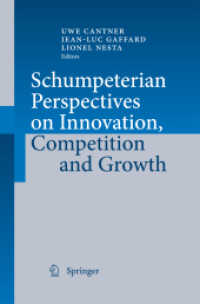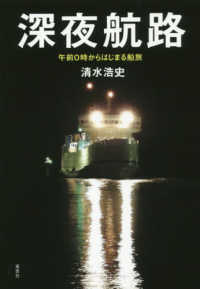- ホーム
- > 洋書
- > 英文書
- > Architecture
基本説明
Selected Contents: 1. Fundamentals and Basic Terminology 2. The Human Far 3. Instrumentation for Noise Measurement and Analysis 4. Criteria 5. Sources and Outdoor Sound Propagation 6. Sound Power, its Use and Measurement, and more.
Full Description
The practice of engineering noise control demands a solid understanding of the fundamentals of acoustics, the practical application of current noise control technology and the underlying theoretical concepts. This fully revised and updated fourth edition provides a comprehensive explanation of these key areas clearly, yet without oversimplification. Written by experts in their field, the practical focus echoes advances in the discipline, reflected in the fourth edition's new material, including:completely updated coverage of sound transmission loss, mufflers and exhaust stack directivitya new chapter on practical numerical acousticsthorough explanation of the latest instruments for measurements and analysis.Essential reading for advanced students or those already well versed in the art and science of noise control, this distinctive text can be used to solve real world problems encountered by noise and vibration consultants as well as engineers and occupational hygienists.
Contents
Fundamentals and Basic TerminologyIntroductionNoise-Control StrategiesAcoustic Field VariablesWave EquationsMean Square QuantitiesEnergy DensitySound DensitySound PowerUnitsSpectraCombining Sound PressuresImpedanceFlow ResistanceThe Human EarBrief Description of the EarMechanical Properties of the Central PartitionNoise Induced Hearing LossSubjective Response to Sound Pressure LevelInstrumentation for Noise Measurement and AnalysisMicrophonesWeighting NetworksSound Level MetersClasses of Sound Level MeterSound Level Meter CalibrationNoise Measurements Using Sound Level MetersTime-Varying SoundNoise Level MeasurementData LoggersPersonal Sound Exposure MeterRecording of NoiseSpectrum AnalysersIntensity MeterEnergy Density SensorsSound Source LocalizationCriteriaIntroductionHearing LossHearing Damage RiskHearing Damage Risk CriteriaImplementing a Hearing Conservation ProgramSpeech Interference CriteriaPsychological Effects of NoiseAmbient Noise Level SpecificationEnvironmental Noise Level CriteriaEnvironmental Noise Level SurveysSound Sources and Outdoor Sound PropagationIntroduction Simple SourceDipole SourceQuadruple Source (Far-Field Approximation)Line SourcePiston in an Infinite BaffleIncoherent Plane RadiatorDirectivityReflection EffectsReflection and Transmission at a Plane/Two Media InterfaceSound Propagation Outdoors, General ConceptsSound Power, its Use and MeasurementIntroductionRadiation ImpedanceRelation between Sound Power and Sound PressureRadiation Field of a Sound SourceDetermination of Sound Power Using Intensity MeasurementsDetermination of Sound Power Using Surface Vibration MeasurementsSome Uses of Sound Power InformationSound in Enclosed SpacesIntroductionLow FrequenciesBound between Low-Frequency and High-Frequency BehaviorHigh Frequencies, Statistical AnalysisTransit ResponsePorous Sound AbsorbersPanel Sound AbsorbersFlat and Long RoomsApplications of Sound AbsorptionAuditorium DesignPartitions, Enclosures and BarriersIntroductionSound Transmission through PartitionsNoise Reduction vs Transmission LossEnclosuresBarriersPipe LaggingMuffling DevicesIntroductionMeasures of PerformanceDiffusers as Muffling DevicesClassification of Muffling DevicesAcoustic ImpedanceLumped Element DevicesReactive DevicesLined DuctsDuct Bends or ElbowsUnlined DuctsEffect of Duct End ReflectionsDuct Break-Out NoiseLine Plenum AttenuatorWater InjectionDirectivity of Exhaust DuctVibration ControlIntroductionVibration IsolationTypes of IsolatorsVibration AbsorbersVibration NeutralizersVibration MeasurementDamping of Vibrating SurfacesMeasurement of DampingSound Power and Sound Pressure Level Estimation ProceduresIntroductionFan NoiseAir CompressorsCompressors for Chillers and Refrigeration UnitsCooling TowersPumpsJetsControl ValvesPipe FlowBoilersTurbinesDiesel and Gas-Driven EnginesFurnace NoiseElectric MotorsGeneratorsTransformersGearsTransportation NoisePractical Numerical AcousticsIntroductionLow-Frequency RegionHigh-Frequency Region: Statistical Energy ANalysis








